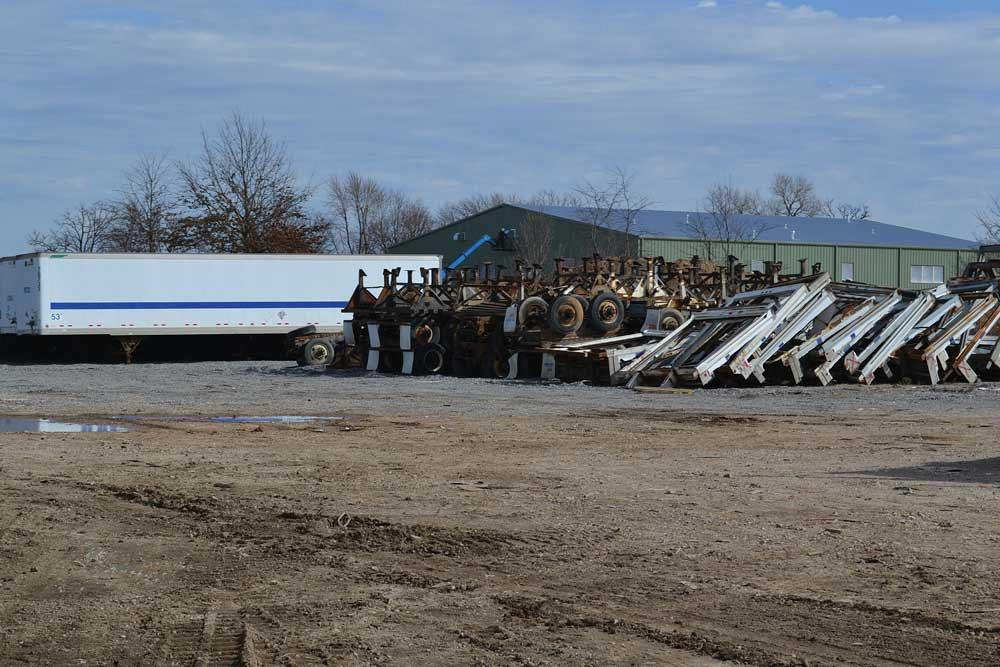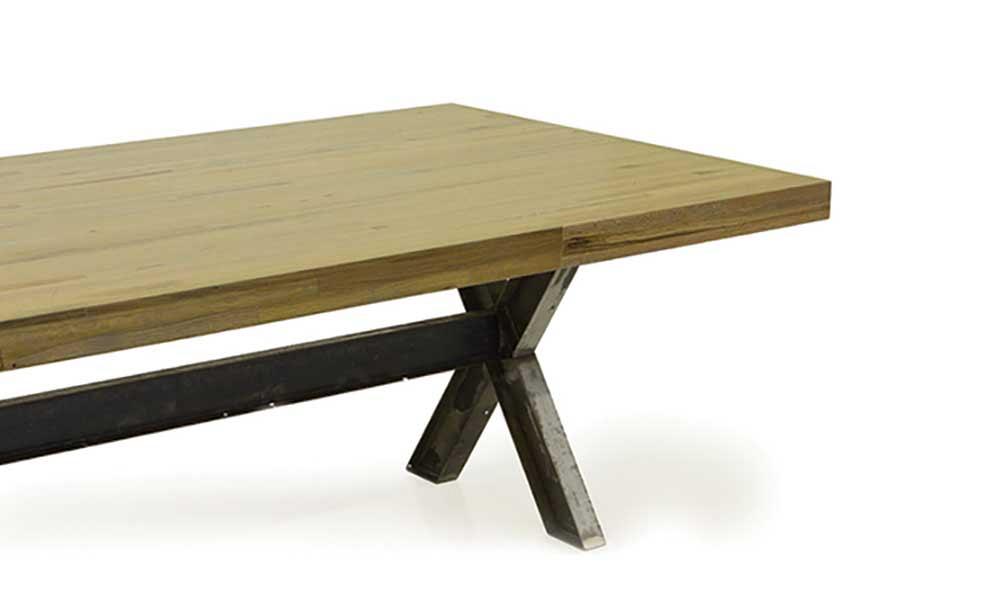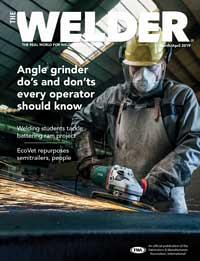- FMA
- The Fabricator
- FABTECH
- Canadian Metalworking
Categories
- Additive Manufacturing
- Aluminum Welding
- Arc Welding
- Assembly and Joining
- Automation and Robotics
- Bending and Forming
- Consumables
- Cutting and Weld Prep
- Electric Vehicles
- En Español
- Finishing
- Hydroforming
- Laser Cutting
- Laser Welding
- Machining
- Manufacturing Software
- Materials Handling
- Metals/Materials
- Oxyfuel Cutting
- Plasma Cutting
- Power Tools
- Punching and Other Holemaking
- Roll Forming
- Safety
- Sawing
- Shearing
- Shop Management
- Testing and Measuring
- Tube and Pipe Fabrication
- Tube and Pipe Production
- Waterjet Cutting
Industry Directory
Webcasts
Podcasts
FAB 40
Advertise
Subscribe
Account Login
Search
Vets rely on plasma cutting for art and furniture venture
EcoVet repurposes wood and metal from semitrailers
- By Sue Roberts
- March 13, 2019
- Article
- Cutting and Weld Prep
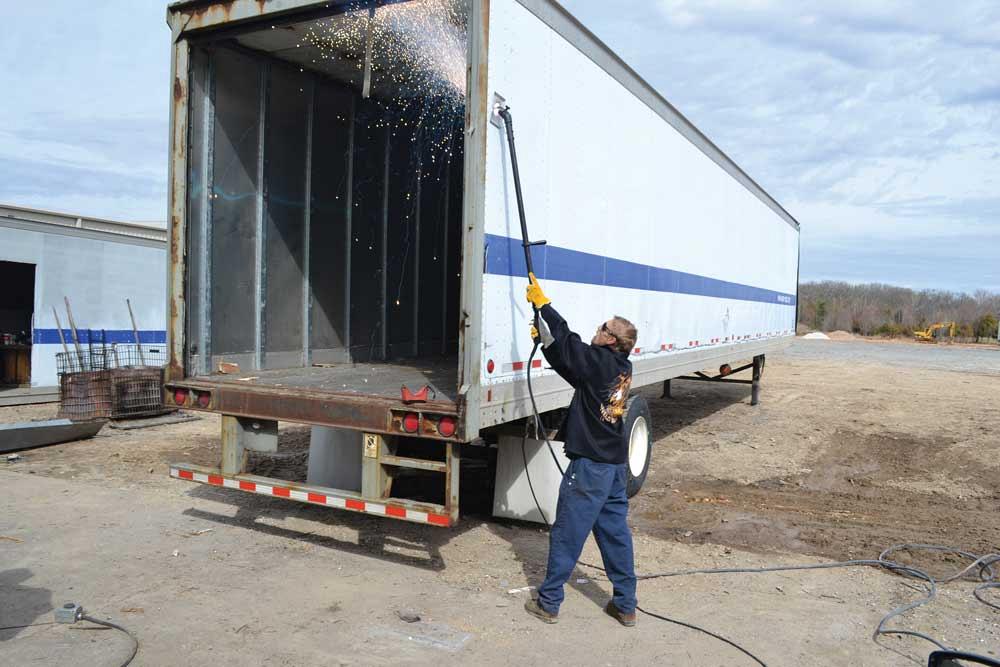
An EcoVet veteran begins the demo process on a retired trailer using a Powermax125 plasma unit (not shown) and a Hypertherm long torch with a skeleton sled attachment.
Mike Hagood, president of EcoVet, enhanced a good idea when he purchased SA Concepts—S for sustainable, A for aerodynamics. Established by Don Vanhooser in 2011, the company used recycled metal from retired semitrailers to produce trailer skirting to reduce wind resistance and improve fuel efficiency. That product focus was paired with a determined effort to provide jobs for returning veterans as a veteran transition company.
A shift to creating custom-designed furniture rather than skirting, and a name change to SA Concepts doing business as EcoVet, came along with Hagood’s ownership in 2013. Eco stands for the continued ecological advantage of recycling retired trailers and Vet for the ongoing dedication to hiring veterans.
Conference tables, bookcases, wall art, wine racks—just about any furnishing or design element that can be imagined—are built in the Rogers, Ark., 15,000-sq.-ft. plant.
The WELDER talked with Hagood about the company and its success.
The WELDER: How did EcoVet evolve from SA Concepts?
Mike Hagood: I was doing some consulting work for SA Concepts when they were using the metal from semitrailers to build trailer skirts. I saw this good-quality wood from the semi flooring that was being discarded and asked them to build me a conference table. It turned out beautiful.
Shortly after that the market for semi skirts changed and the company was going to close. A friend of mine who buys businesses and I thought the company was a good thing that just needed to be tweaked. We bought it and started making furniture.
There are two parts to the company today. The demolition side has teams that tear down the trailers, and the building side provides the custom designs and uses the reclaimed materials to build furniture and art.
We recycle or sell everything we don’t use. We sell axles, landing gear, aluminum, and even some I-beams and wood.
TW: Do veterans make up the majority
of employees?
MH: Four or five veterans made up the entire workforce when we purchased the company. Today our count fluctuates, but it is usually about 20 to 25. We hire veterans whenever we can, and we work with the vets to provide a living wage. We provide the flexible hours they need if they are going to school so they can get a jump on their future.
With the tight workforce, though, there are times when we have to hire other workers to meet production. Our goal is to maintain a ratio of at least 50 percent of employees being people who have served.
TW: Do you provide training?
MH: Absolutely. We have designated trainers. A lot of the people we hire have no woodworking, fabricating, or welding experience. After about 90 days here they can build anything. What is unique about the individuals in this type of work is that they can do anything needed—demo, weld, finish, build. They are very handy with their hands and understand how to fix things.
TW: What makes EcoVet’s furniture unique?
MH: Our furniture has an industrial look that customers get excited about, but each piece is custom. A designer sits down with each customer and helps create the design according to their specifications. As an example, some people want the reclaimed wood for their project to be left rough to show the history of the wood—they don’t want it planed or sanded. Some want it without a blemish so that wood goes through finishing.
One thing we don’t do is make lightweight furniture. The wood is a mix of 11⁄4-in. oak or maple that weighs about 5 lbs. a foot. Metal from the trailers is incorporated into a lot of our designs, and we buy bases and other metal structures depending on what the design needs.
TW: What kind of problems can occur when working with reclaimed materials?
MH: Most of the trailers we use have been on the road since the 1980s or early 1990s. The wood flooring has been glued together. The wood has to be separated, dried, and put together properly to work in its next life. Some of the wood will split, but a lot of customers think this adds to its industrial look.
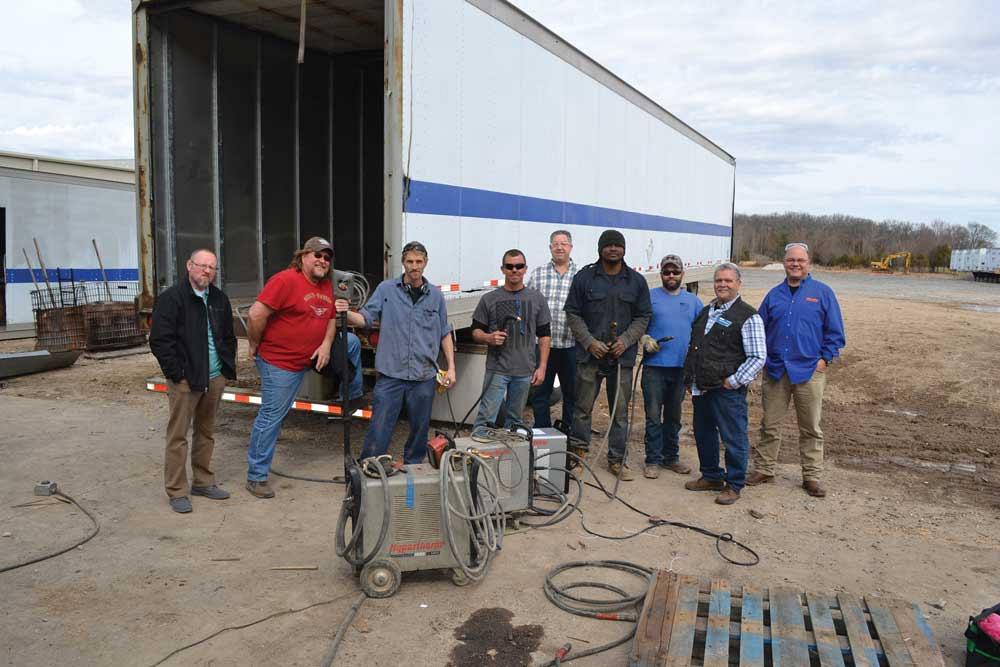
A demolition team gathers by a trailer that will provide materials for the woodworking, finishing, and welding shops.
On the metal side, say when we are building a frame for a table, the I-beam or sheet metal can twist, but our guys have learned about the metal properties and figured out how to work with it.
We’ve learned to overcome the issues involved with working with reclaimed materials. From time to time we need to go out and do repairs, but we don’t face those kinds of issues much anymore.
TW: What happens when the trailers hit your yard?
MH: Normally we buy 40 or 50 trailers at a time and they arrive in bulk. The yard is just under 4 acres so there is plenty of room. We go through them quickly. We’ve gone from demolishing 40 trailers a year to 40 a month. One team demos the metal and another team handles the wood. Our goal is to demo two trailers a day so the reclaimed wood and metal can be cleaned and available in our woodworking, welding, and finishing shops.
TW: What equipment does the demo team use to recover the metal?
MH: A lot of plasma cutting is used during demo operations. Guys on the demo teams use Powermax125 systems with 4-ft. Duramax Hyamp long torches. Hypertherm brought us the lead with the 4-ft. torch when they saw us using forklifts, scissor lifts, or ladders to cut at the top of the trailers’ walls. The long torches really sped up the operation. My guys can stand on the ground and do the cutting without needing additional equipment, and it’s much safer.
Recently we’ve started using an add-on to the plasma torches, called a skeleton sled, that makes the cutting process easier to control. It prevents the tip of the torch from touching the trailer surface. Again, it was a Hypertherm recommendation. We were one of the first companies to use the sled.
TW: How do people find out about EcoVet furniture?
MH: Almost all of our business comes from word-of-mouth and repeat customers. There is a large vendor community here in northwest Arkansas, and we have been fortunate to do a tremendous amount of work with some of the designers, architects, and builders.
Photos of our work are posted on our Facebook page and our website. We also get a lot of publicity, a lot of media exposure, because of our sustainable practices and our dedication to vets. The Rogers-Lowell Area Chamber of Commerce recognized us as the Small Business of the Year for 2017, and we were one of the companies featured in Parade magazine’s Earth Day issue last April.
TW: Do you anticipate selling through retail outlets at any point?
MH: For now we strictly build for custom. We sold through a retail website and a catalog company for a while. Making production pieces needs a different type of shop, and production management can present its own set of problems. But we’ve been approached to renew sales through a retail site. Maybe in the future.
Freelance writer Sue Roberts can be reached at sueroberts4545@gmail.com.
EcoVet Furniture Co., 479-319-1907,
Smoothing the cut
Creative customers like EcoVet have adopted two Hypertherm products that were originally developed to ease issues involved with cutting sheet and plate skeletons. Combining the two products can help operators complete tasks faster with less fatigue and strain. One is a Duramax® Hyamp™ long torch that is available in 2-, 4-, and 6-ft. lengths. The other is a torch attachment called a skeleton sled.
Mark Hartness, Hypertherm district sales manager for Arkansas and Louisiana, saw how these two products would fit with EcoVet’s productivity objectives.
“EcoVet’s production goals included getting demolition done 30 percent faster while lowering costs. Management also wanted a versatile cutting tool that would reach up high so operators wouldn’t need ladders and lifts when cutting and reach down low to reduce bending over or slouching for the lower cuts,” Hartness said.
“EcoVet was one of the first businesses to use a Duramax Hyamp long torch that was originally designed for scrapping skeletons. The 4-ft.-long torch works well for these guys while they decommission trailers. They can stand on the ground and take the cut high or low without any issues.
“Switching to plasma was also a big help. They are cutting about five times faster with the Powermax125 than when they were using oxyfuel.”
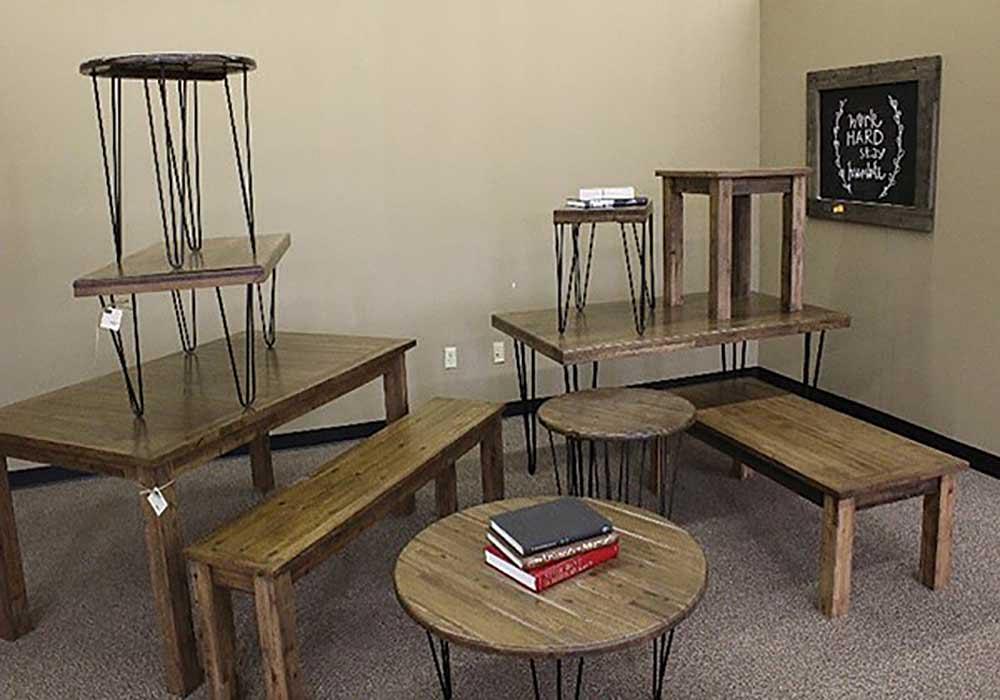
Repurposed wood and metal from retired trailers are used for EcoVet custom-built products, keeping the trailers from ending up in landfills.
Even though skeletons aren’t a byproduct of their production, EcoVet was also one of the first companies to use the Hypertherm skeleton sled, also called the long torch sled, which was introduced last year.
Jeff Hluchyj, product manager for Hypertherm’s light industrial systems, talked about the development of the sled. “We saw an opportunity to improve the long torch products by making it easier for operators to control the tip of a torch as they were guiding it several feet away from them—to find a way to help it glide more smoothly over the top of skeletons.
“Even though the sled was designed with skeletons in mind, it’s been adopted by many different industries and is being used in a variety of applications. It is being used for scrapping, bridge demolition, and cutting weld test coupons.”
Skeleton sleds attach to the torch ends. A 5- by 7-in. base plate supports the torch, making it easier for the operator to cut along uneven surfaces. If a cut is made horizontally, the sled supports the torch weight. A lightweight combination of a 4-ft.-long torch at 11.4 lbs. and a sled at just under a pound helps minimize operator fatigue when cutting vertical applications.
Hartness said, “During EcoVet trailer demos the torch is 4 ft. away from the operator. The sled holds the torch in a straight position so the operator doesn’t need to deal with surface ups and downs and end up with deviations in the cut. He positions the torch and sled, drags them, and the cut is made.”
Hypertherm Inc., www.hypertherm.com
About the Author

About the Publication
Related Companies
subscribe now

The Welder, formerly known as Practical Welding Today, is a showcase of the real people who make the products we use and work with every day. This magazine has served the welding community in North America well for more than 20 years.
start your free subscription- Stay connected from anywhere

Easily access valuable industry resources now with full access to the digital edition of The Fabricator.

Easily access valuable industry resources now with full access to the digital edition of The Welder.

Easily access valuable industry resources now with full access to the digital edition of The Tube and Pipe Journal.
- Podcasting
- Podcast:
- The Fabricator Podcast
- Published:
- 04/16/2024
- Running Time:
- 63:29
In this episode of The Fabricator Podcast, Caleb Chamberlain, co-founder and CEO of OSH Cut, discusses his company’s...
- Industry Events
16th Annual Safety Conference
- April 30 - May 1, 2024
- Elgin,
Pipe and Tube Conference
- May 21 - 22, 2024
- Omaha, NE
World-Class Roll Forming Workshop
- June 5 - 6, 2024
- Louisville, KY
Advanced Laser Application Workshop
- June 25 - 27, 2024
- Novi, MI
























